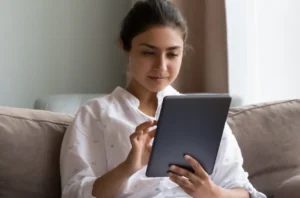Delivering a memorable user experience requires more than just new technology. It requires an entire digital transformation that includes adjustments to organizational structure. A new Origence white paper reveals the important, if not necessary, role organizational structure plays in achieving digital transformation and delivering new technology.
Digital technology has become so prevalent in our lives, the effectiveness of digital transformation starkly affects the bottom line. According to Harvard Business Review, of the $1.3 trillion that was spent on digital transformation in 2018, about $900 billion went to waste.
How much will companies spend on digital transformation in 2020? The experts appear split on whether tech spending will increase or decrease this year as a result of the coronavirus pandemic. However, even companies hit hard economically have accelerated some digital strategies. To this point, research firm Gartner predicted in a May 2020 report that spending on cloud services will increase by 20% this year.
Why is organizational structure important when it comes to digital transformation? According to Maaren Wensveen, CTO at customized goods provider Cimpress, it’s because companies tend to create products and services that mirror their organizational charts and communication structures, which were built to support legacy business channels.
Wensveen explained in a September 2019 Forbes article that traditional, hierarchical organizations force product development teams to meet the demands of project managers, financial analysts and others who mean well, but create a product and delivery system that meets the needs of the company rather than the consumer. This can lead to an overly complicated and disengaged customer experience, and ultimately, a failed digital transformation.
Not only that, but Wensveen said hierarchical organizational structures and overly complicated approval processes slow product development and innovation cycles so much, by the time customer needs are addressed, the rest of the world has already moved on.
The great digital shift
Many business leaders who had already completed successful digital transformations that included cultural and organizational changes were able to quickly transition to digital sales and work from home arrangements when COVID-19 shut down much of the economy. Business leaders who had previously looked at digital channels as mere technology experienced drastic changes in the way they do business.
The auto industry is a good example of the latter. CUDC President Brian Hamilton observed digital auto sales had been available to both retailers and consumers for many years but attracted low adoption because both buyers and sellers were entrenched in the legacy in-person dealership retail models. Auto dealers concluded that it’s simply a fact that people like to see, feel and drive a car before they purchase it.
Well, that mindset has changed dramatically. Hamilton said digital auto sales represented less than 5% of total sales before COVID-19 shut down nonessential, in-person business. At the height of shelter-in-place orders, digital sales skyrocketed to 70% of total sales. As consumers venture back out into the world, we expect digital sales will still remain high, perhaps around 25%, because both consumers and dealers discovered they like digital sales. That means the organizational structure of dealerships will also change, shifting more resources and talent toward a digital experience.
This example is specific to the auto industry, but a similar shift has occurred across all industries, including financial services. Experts say it takes an average of 66 days for a new behavior to become automatic. Stay at home orders in many areas lasted at least 60 days, with social distancing making in-person shopping and errands uncomfortable and inconvenient.
Like digital sales, remote work has been around for years, but adoption has been slow. Now that systems are in place to allow work from home, and both employers and employees have developed work from home processes and habits, it’s expected that adoption will remain historically high.
Transformation doesn’t require a total reorganization
Silo-based organizational structures continue to rob many credit unions of their ability to transform into agile, digitally-driven organizations, said Paul Kirkbride, Chief Credit Officer at the $3.3 billion WSECU in Olympia, Wash. He noted that it wasn’t that long ago that WSECU was one of them.
Rather than completely reorganize the credit union to eliminate silos, WSECU created four cross-functional teams that work within the traditional credit union organizational structure.
These teams, which include eight to 16 people, don’t own products but rather, focus on a member process or mode. The four teams include utilization, assistance, awareness and acquisition.
The credit union also created a member experience department, referred to as the MX Group, headed by a VP of Member Experience who reports to the credit union’s Chief Operational Officer. The MX Group, which has a representative on each cross-functional team, is in charge of a “voice of the member” platform. The platform collects and reports data from member surveys and unsolicited member feedback, keeping an eye on any friction in the member journey.
New talent needed: MX and BI
More apps and more upgrades mean credit unions must constantly evaluate how new technology affects the member experience, which means a larger investment in MX. Texas Tech FCU, a $203 million institution in Lubbock, Texas, has an applications team that, like WSECU’s MX Group, focuses on both the member-facing and back office functioning and processes of each app.
“You have to represent both because back office employees tend to be very efficiency-driven, while front office people are very member experience driven,” said Lisa Huertas, Texas Tech FCU Chief eXperience Officer.
Huertas credited the credit union’s board for being early digital adopters and allowing the executive team to make necessary investments, like a business intelligence team that includes two full-time data scientists.
Huertas acknowledged that most credit unions their size don’t have a BI team, but Huertas said the BI team has paid for itself in smarter business decisions, thanks to the data and analysis they’ve produced.
“Whether your technology is in-house or outsourced, data points are so critical to understand the credit union’s 360-degree view. It’s one of the most critical investments you can make,” she said. “First you have to bring it all together, then you can innovate from there.”
Changes to your organizational structure is just one of the sweeping changes that need to occur within an organization to support a successful digital transformation. Credit unions must also shift their culture and attitudes toward digital technology, as well as the needed adjustments to their budgets.
You can learn more about how credit unions have successfully made the transition by downloading our free white paper, “Digital Transformation Goes Beyond Just the Technology.” This special report includes research from industry technology experts and Filene Research.


















